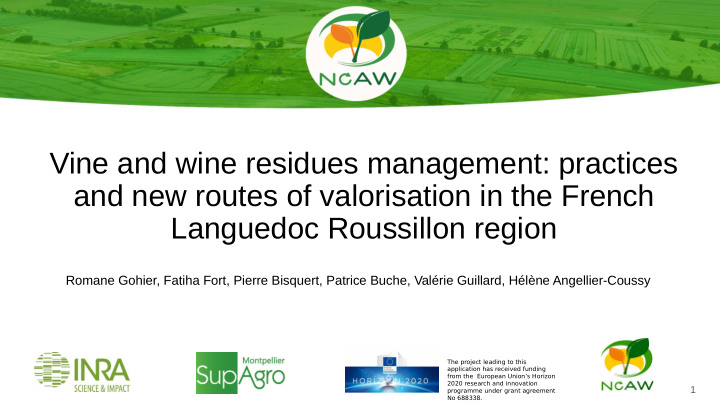



Vine and wine residues management: practices and new routes of valorisation in the French Languedoc Roussillon region Romane Gohier, Fatiha Fort, Pierre Bisquert, Patrice Buche, Valérie Guillard, Hélène Angellier-Coussy The project leading to this application has received funding from the European Union’s Horizon 2020 research and innovation 1 programme under grant agreement No 688338.
INTRODUCTION In the vine and wine production sector, huge amounts of waste and by-products are generated each year in France: 1.6 million tons of wood pruning, 850 000 tons of grape marc, 1.5 million hectolitres of wine lees and wastewater. Since one century, French distilleries valorised the wine by-products. Since the French decree n° 2014-903 winemakers are authorized to valorise by themselves their by-products through methanization or spreading. The Languedoc Roussillon region is the most important French area for the vine and wine industry as regards of volume produced.
RESEARCH OBJECTIVES This study aims to: - Provide a clear picture of the current situation as regard the nature of wastes generating by the vine and wine sector and collecting all relevant information to understand why a waste management system is preferred among all the other existing valorization routes - Evaluate the new technologies acceptance and potential development
METHODOLOGY Different stakeholders have been interviewed through face-to-face interviews in July and August 2018 Two focuses: 1/ Interviews of 12 winemakers with semi-directive discussion, transcribed and analysed with a thematic analysis 2/ Surveys of 6 winemakers, 2 distilleries and 3 public decision- makers, analysed with NoAWVote Typology and repartition of interviewees in the Languedoc Roussillon
RESULTS
1- Current valorisation routes Current prefered valorisation routes: distilleries and fertilization Choice criteria ranked by wineries: 1. Low economic-cost 2. Low environmental impact 3. Ease of use / convenience For the policy-makers the main criteria is the low environmental impact.
2- Management of wine by-products Collection logistics of grape pomace and wine lees is organised by distilleries. Globally satisfied of this long term commercial relationship Advantages mentioned Constraints mentioned: - Compliance with legal - Producers of small quantity have requirements to organise the transportation - Low cost of the valorisation - Grape pomace separation pathway - Convenience in periods of high activit y Almost no use of the oenological products made by distilleries.
3- Management of wastewater and vine by-products There is no specific collection and post-treatment proposed to vine growers. Three type of vine by-products: - Vine shoots: crushed and left in the vineyard, or burnt - Vine roots : firewood or wood barbecue - Grape stalks : spread in the vineyard Different options are possible for the wastewater treatment but none of these seems to satisfy them because of the cost, labour time and administrative complexity.
4- Preferences of stakeholders as regard new valorisation routes
5- Expected benefits and potential obstacles
DISCUSSION AND CONCLUSION The results of this study not only highlight the crucial role of distillery in the wine by-products management and for the circularity of the wine sector, but also enhance: (1) The winemakers disempowering and lack of information regarding the environmental impact of winemaking (2) The distillery vulnerability because of their business model based on public subsidies (decrease of processing aid) (3) The challenge to attain a critical size motivated by the economic performance but which implied a lower environmental performance due to transport and logistics.
Recommend
More recommend